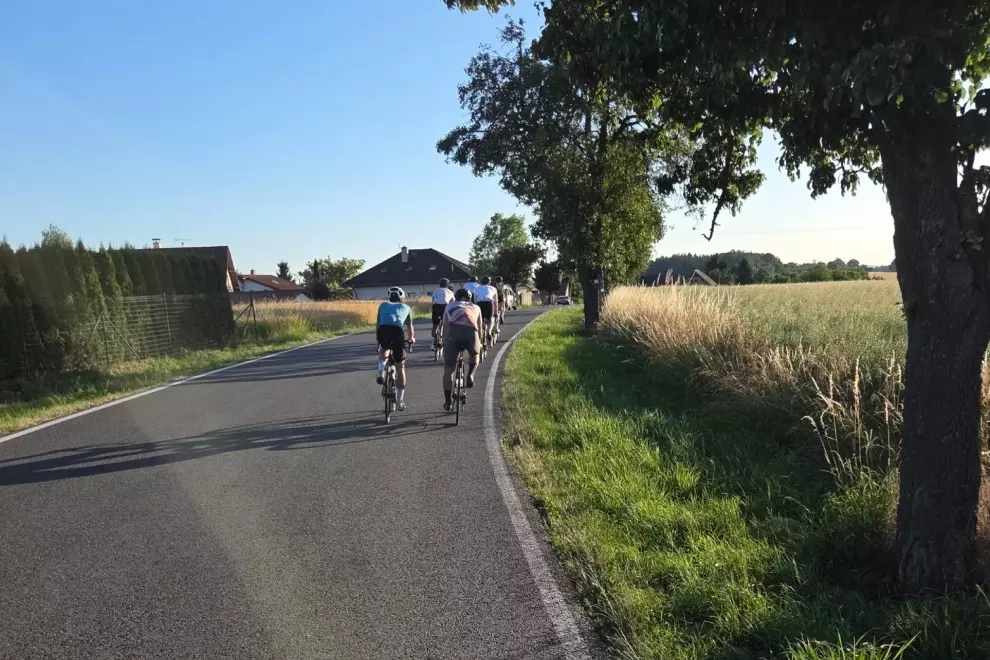For smaller dogs, breeds with lower stamina or those with health issues—it is best to opt for a bike trailer or basket (more on that below). If strenuous exercise is not a concern, though, riding a bike is an excellent form of exercise for your dog and can also help to address any energy surpluses that may manifest in less desirable behaviours. Whatever the case may be, let’s go over a few of the things you need to be aware of before trying to ride a bike with your dog.

Determine if you’ve got a runner or a passenger
Before you get your heart set on having your pup run alongside you as you pedal, you must confirm they are up to the task. Be mindful of the fact that some dogs, including short-nosed breeds, dogs who are overweight or those who have health issues, are not built for runs. As explained by Haylee Bergeland, Daily Paws’ pet health and behaviour editor, “Not all breeds are meant for biking! Dogs that are brachycephalic (like bulldogs) have a hard time breathing normally, so rigorous exercise like biking is not a good idea.” She also says that, “large, heavy dogs and older dogs will not enjoy biking as it is too rough on their joints. Dogs with thick, heavy coats may also find it too uncomfortable.”
Of course, some dogs do love going on longer runs. To stay on the safe side, though, it is best to check with your vet before starting your pooch on any kind of new exercise regimen.
Take baby steps to get your dog comfortable around a bicycle
As more cyclists have endeavoured to get their dogs involved in their hobby, there are now special bike attachments designed for dogs to run alongside their humans. But before you get started, though, you need to confirm that your dog is comfortable around a bike, can remain calm, and will be able to follow your instructions. From the sound a bike makes to the way it moves, there are plenty of things about your beloved steed that can give a dog reason for pause (pun intended)—so take it slow.
Begin by simply putting the dog next to the bike to get her used to the sounds and movements before going for a ride together. You can also use treats during the stage to create positive association and reinforcement with your bicycle. Then, as your dog comes to associate the bike with good things, you can work on developing the level of comfort and confidence they will need to run alongside you. Keep in mind that this process may take time, though, so patience is key.

Set realistic targets and work up to longer outings
Unless you’ve already got a vigorous running routine established with your dog, you’ll need to work on building stamina before your dog can accompany you on longer jaunts. When starting out, your dog’s muscles and paw pads are not used to running in this way—running consistently alongside a bike (even if you’re going pretty slow) is a lot different than playing for hours in the yard. The hard surfaces that make cycling a breeze can be hard on or even dangerous for your dog. Start with 5-10 minute outings and work your way up slowly.
Invest in a good leash
These days, it is easy to find specialised dog leashes for biking. They attach to your bicycle’s seat post or rear axle and are ideal for running dogs that require leashing due to traffic or temperament. Leashes such as the Bike Tow Leash and Walky Dog Plus leash will help protect your dog from pedals, wheels and traffic. The specially designed coiled springs will also act as shock absorbers in the event of an unexpected tug.
Top carriers for your pooch
If you’ve decided that the best way to enjoy cycling together is to carry your dog, then you must find a basket or carrier that is comfortable and appropriate for the kind of riding you’ll be doing.
Some of our top picks include:
Back of the bike: Trixie Foldable Dog Bike Trailer
Water-resistant and reinforced with a steel frame, this dog carrier for bikes hitches to the back of your frame so your pup can ride in comfort. It also features a safety strap, reflectors, and flag for added security and folds up for easy storage post-ride.
Front of the bike: Snoozer Buddy Bike Basket
Durable, comfortable, and indisputably cute—this dog carrier for bikes comes in three colours and has extra pockets for you and your dog’s belongings. It has a removable pad and chin rest —plus a weather cover for those days when the elements speak up unexpectedly.
A wearable option: K9 Sport Sack Dog Carrier
Ideal if you’d also like to do some hiking with your dog in tow, these backpacks come in four sizes—with the largest size holding dogs up to 35 pounds. Your pup’s head and front paws are visible and unencumbered while their lower half is tucked safely inside, sitting on a rest pad. Zippered vents, a collar hook-up, and a chest strap provide extra comfort and security.
The final word on biking with your dog
If your canine pal is up to running, it is critical that you keep a close eye on them while you do so—both while you’re out and about and once you get home. Be mindful that dogs simply don’t have the same kind of stamina as humans do and that you should avoid taking your dog out when it’s too hot, you’re planning to do a challenging route or you want to tackle a rough trail. The ride should be a slow and easy one, with plenty of opportunities for breaks. Check-in with your dog often to make sure they are enjoying the activity and are not getting too tired. Once you can visibly or audibly tell that your pup is tired, it’s time to call it a day.






